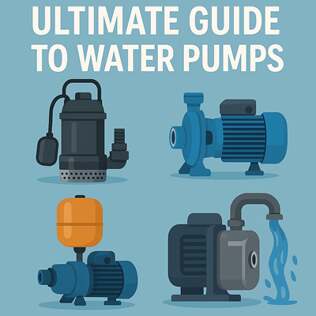Quick Fixes & Maintenance for Electric, 12V and Hand Pumps: Common Problems & Repairs
Electric Water Pumps: Keeping Homes and Gardens Flowing
An electric water pump is often the backbone of household supply, irrigation setups, or even a sump pump in a basement. Common issues usually show up in three ways:
- No power or tripped breaker: Check outlets, fuses, and cords before assuming the pump itself has failed. Sometimes a loose wire inside the motor housing is the culprit.
- Loss of pressure: If your electric or booster pump runs but the faucet dribbles, debris could be clogging the impeller. Cleaning it usually restores normal function.
- Constant cycling: Often linked to a faulty pressure switch or a leaky line leading back to the water pressure tank. Tightening connections or replacing the switch can stop the short cycling.
Tip: Always prime centrifugal style electric pumps before use. Running them dry, even for a minute, can burn out seals quickly.
12V Water Pumps: Compact but Temperamental
Found in RVs, boats, off grid cabins, and even small garden setups with a solar water pump, these pumps thrive on portability. But they are more sensitive to wear.
- Pump not starting: Corrosion on the battery terminals or a blown inline fuse is often the first place to look.
- Intermittent flow: A clogged inlet screen or a kinked hose starves the pump. Cleaning or straightening the line usually brings back steady water.
- Low output pressure: Check for air leaks in the suction line. Even a hairline crack in a fitting can cause the pump to sputter and struggle.
Keep a small repair kit handy with extra diaphragms and valves. These parts wear faster in 12V pumps compared to larger submersible or centrifugal pumps.
Hand Pumps: Simple, Rugged, but Not Maintenance Free
A hand pump is often considered the most reliable type of pump since it has no motor. But they do have moving parts that need attention.
- Handle too stiff: Usually points to dry seals. Applying food grade grease or replacing worn leather seals solves the issue.
- Pump not drawing water: The foot valve may be stuck open, or the well water level might have dropped below the pump’s reach. Lowering the pipe or cleaning the valve usually restores function.
- Leaky spout: Gaskets and washers deteriorate with age. Swapping in new rubber washers is a quick repair.
These pumps shine in rural wells and garden setups, especially when paired with rainwater harvesting. Their simplicity makes them irreplaceable as a backup when power outages hit. #waterpumps #pumprepair #wellpump #12vpump
Preventive Maintenance: Small Habits, Big Results
Most water pump breakdowns trace back to neglect. Regular maintenance can save both time and money:
- Flush sediment out of submersible water pumps and well pumps annually.
- Inspect hoses and seals on pond pumps, irrigation pumps, or trash pumps for cracks before peak season.
- Run your sump pump briefly every few months, even in dry weather, to ensure it kicks on when the basement needs it.
- Clean filters and strainers regularly. Dirt and debris act like sandpaper on pump internals.

